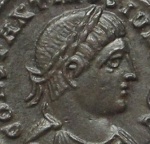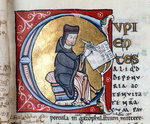ouais bof
5 participants
Page 1 sur 1
 ouais bof
ouais bof
LE MEDAILLON DU PAUVRE

Constantine I, 307 – 337. Medallion of 1 1/2 solidi, Antiochia 326, AV 6.59 g.
D N CONSTANTINVS MAX AVG Radiate, draped and cuirassed bust l., raising r. hand and holding globe in l.
Rev. CONSTANTINVS ET CONSTANTIVS NOBB CAESS Confronted laureate busts of Constantine II and Constantius II, each wearing consular trabea and holding eagle-tipped sceptre in one hand and globe in the other; in exergue, SMAN. RIC 70. Gnecchi p. 23, 1 and pl. 8, 15. Alföldi 63. Toynbee p. 197. Kent-Hirmer pl. 162, 643. Depeyrot p. 155. Bastien, Donativa, p. 79 note 13.
Of the highest rarity, the finest of only three specimens known of this fascinating
issue. Well struck on a broad flan and about extremely fine / extremely fine
Ex Sternberg XXIX, 1995, 528 (illustrated on the front cover page); Triton I, 1997, 1698; NAC 24, 2002, European Nobleman, 279 and NAC 54, 2010, 616 sales.
Taking a page from the Severan numismatic playbook of the early third century, this fabulous gold medallion serves to illustrate Constantine the Great’s concern for the welfare of the late Roman Empire. It advertises his sons, Constantine II and Constantius II, as Caesars (i.e. junior emperors) who would succeed him when he died and carry on the established administration. In short, the medallion presents an image of dynastic stability and implies a smooth transition of power from one ruler to his sons, thereby sparing the exhausted Roman people of yet another destructive civil war. This was important to emphasize since the Tetrarchic system, introduced by Diocletian and Maximianus to solve the same problem in A.D. 286 was ultimately a failure that plunged the Roman world into a series of civil wars between A.D. 309 and 324. The types here attempt to convince us that the tried and true method of smooth dynastic succession from father to sons would save the day in the end.
The medallion was struck, perhaps not coincidentally, almost 125 years after the dynastic series of Septimius Severus. Constantine the Great’s radiate crown seems to be a deliberate throwback to the third century. This medallion was probably distributed as largesse to the army on the occasion of Constantine’s vicennalia (twentieth anniversary as emperor) celebrations that began in mid-A.D. 325 and continued until the final celebration at Rome in July of A.D. 326. In A.D. 326, Constantine the Great shared the consulship with Constantius II for the first time and it is for this reason that the latter is depicted here wearing ornate consular robes and holding the eagle scepter of office. Constantine II had previously served as consul with his father and therefore also appears in his consular attire to complete the symmetry of the reverse type.
Unfortunately, while this medallion is very Severan in its attempt to present the image of a stable and happy dynastic household, it really serves only to plaster over the serious cracks in the house of Constantine. Just as the dynastic coinage of Septimius Severus covered up the deep hatred between his sons, the types of this medallion give no hint that later in A.D. 326 Constantine the Great would order the public execution of his eldest son, Crispus, and the secret drowning of his wife, Fausta.

Licinia Eudoxia, daughter of Theodosius II and wife of Valentinian III. Solidus, Ravenna after 6th August 439, AV 4.43 g.
LICINIA EVD – OXIA P F AVG Draped bust facing, wearing pearl necklace and a radiate crown.
Rev. SALVS RE – I PVBLICAE Empress, nimbate, enthroned facing, holding cross on globe in r. hand and long cruciform sceptre in l.; in field, R – V. In exergue, COMOB. C 1. RIC 2023. Biaggi 2356 (this coin). LRC 870. Lacam vol. I, pl. V (this coin). Depeyrot 16/2.
Extremely rare and possibly the finest specimen known. A wonderful and
interesting portrait perfectly struck and centred on a full flan.
Virtually as struck and almost Fdc
Ex Santamaria 1924, Marchese B.L., 669; Glendining 1950, Platt Hall part II, 2095; Leu 22, 1979, 409 and NAC 38, 2007, 296 sales.
As described in the commentary on the ‘marriage solidus’ of Valentinian III (previous lot), no woman in the Roman Empire could compare with the nobility of Licinia Eudoxia. As an Augusta who was the daughter of the eastern emperor Theodosius II and the wife of the western emperor Valentinian III, she was among the most influential people of late antiquity.
Though Licinia Eudoxia had coins struck for her with the usual profile portrait, we have here a remarkable solidus with a full-facing bust, adorned with strings of pearls and a radiate crown, the rays of which flank a cross. The powerful imagery of this portrait, though impressive on our coin, must have been even more imposing in the flesh with the radiant colors of her richly woven garments and an overpowering display of pearls, precious stones and her golden crown.
Frontal portraits on Roman coins were a rarity before the reign of Constantius II (337-361), at which point emperors came to be routinely shown full-facing, holding a shield and spear. But beyond this standard type, facing portraits were still uncommon even in the 5th Century, and this one of Eudoxia is of great iconographic value.
The date of this solidus is a matter of speculation. There are two main issues of solidi bearing frontal portraits of Eudoxia: the first, struck at Ravenna and Rome, bears the obverse and reverse type of this piece (RIC 2016 and 2023); the second issue, from Rome (RIC 2046), bears a reverse celebrating the tricennalia of her husband Valentianian III and has a portrait of a different character, for Eudoxia wears consular garb and her crown has two large triangular projections rather than six radiate spikes.
The second issue is dateable to late 454 through early 455, for Valentian III entered his eighth and final consulship on January 1, 455 and he was then celebrating his tricennalia, the period of which would have been October 23, 454 through March 16, 455 (when he was murdered in a palace coup organized by his successor, Petronius Maximus).
The relation of that consular solidus of Rome to the present coin (and its sister-issue of Rome) is a matter of speculation; except for the fact that they all bear a facing portrait of Eudoxia, there are few similarities in style, and, as already noted, the details of the busts vary.
The reverse of our coin, inscribed SALVS REIPVBLICAE and showing the nimbate, enthroned, empress, likewise offers no obvious chronological clues. Kent assigns our solidus to a group broadly dated to c. 430-c. 445, and Grierson and Mays prefer the year 439 specifically, seeing it as a commemorative issued when Eudoxia assumed the title of Augusta.

Licinius II caesar , 317 – 324. Aureus, Nicomedia 320, AV 5.32 g.
D N VAL LICIN LICINIVS NOB C Draped and cuirassed bust facing.
Rev. IOVI CONSER – VATORI CAES Jupiter seated facing on platform holding Victory on globe and sceptre; at feet, eagle with wreath. The platform is inscribed SIC V / SIC X. In exergue, SMNΕ. C 28. RIC 42. Alföldi 254 var. (off. Δ). Depeyrot 31/2. Calicó 5150.
Very rare and in an exceptional state of preservation, one of the finest specimens known.
A magnificent portrait well struck in high relief. Virtually as struck and almost Fdc

Constantine I, 307 – 337. Solidus, Treviri early 316, AV 4.40 g.
CONSTANTI – NVS P F AVG Laureate head r.
Rev. VICTO – RE – AV – G – N Victory seated r. on cuirass, shield, behind, inscribing X / XX on shield set on knee; to r., trophy between two captives seated on ground. In exergue, P TR. C 576. RIC 86. Alföldi 535. Depeyrot 22/6.
Virtually as struck and almost Fdc

Constantine I, 307 – 337. Heavy miliarense, Sirmium 320-324, AR 4.76 g.
CONSTANTINVS MAX AVG Bare head of Constantine r. R
ev. CRISPVS ET CONSTANTINVS CC Confronted heads of Crispus, l., and Constantine II, r.; in exergue, SIRM. C 3. Gnecchi I, p. 59, 1 and pl. 29, 8. RIC 14.
Very rare and in exceptional condition for the issue. Struck on unusually
good metal and with three interesting portraits. Good extremely fine

Constantine I, 307 – 337. Solidus, Antiochia 324-325, AV 4.42 g.
CONSTANT – INVS P F AVG Laureate head r.
Rev. ADVENTVS – AVGVSTI N Emperor on horseback l., cloak flying, raising r. hand and holding spear in l.; in exergue, SMANá. C 11. RIC 48 (this coin mentioned). Alföldi 5. Depeyrot 41/1.
Extremely rare. Several light marks on reverse, otherwise good extremely fine
Ex M&M XIII, 1954, 762; Hess-Leu 24, 1964, 356; Hess-Leu 45, 1970, 645 and Leu 91, 2004, 689 sales.

Constantine I, 307 – 337. Solidus, Thessalonica circa 326, AV 4.51 g.
Diademed head r.
Rev. VIRTVS CO – NSTANTINI AVG The Emperor, in military attire, standing l. and holding trophy and shield; at his feet, two captives. In exergue, SMTS. C –. RIC –. Depeyrot 12/1. Bastien, Donativa p. 78, a.
Rare. A spectacular portrait of fine style struck on a full flan, good extremely fine
Ex NAC sale 27, 2004, 512.

Constantine I, 307 – 337. Solidus, Thessalonica 326, AV 4.59 g.
CONSTAN – TINVS AVG Laureate head r.
Rev. VIRTVS CON – STANTINI AVG The Emperor, in military attire, standing l. and holding trophy and shield; at his feet, two captives. In exergue, SMTS. C –. RIC –. Depeyrot cf. 12/1 (diademed head, no legend on obverse). Bastien, Donativa p. 78, a. Gorny & Mosch 207, 2012, 701 (these dies).
An exceedingly rare variety. In exceptional condition, virtually as struck and Fdc

simo75- Miliarense léger

- Messages : 1905
Date d'inscription : 20/08/2013
Age : 48
 Re: ouais bof
Re: ouais bof
c'est la prochaine vente NAC (100) si quelqu'un voudrait miser dessus...

simo75- Miliarense léger

- Messages : 1905
Date d'inscription : 20/08/2013
Age : 48
 Re: ouais bof
Re: ouais bof
S'il ne s'agissait que de vouloir...
Je mise les deux premiers, quelqu'un pour les autres ?

Je mise les deux premiers, quelqu'un pour les autres ?
 Re: ouais bof
Re: ouais bof
la vente 100 part II c'est pour les working poors, mais on trouve quelques beautés

Constantine I augustus, 307 – 337. Solidus, Ticinum circa 324-325, AV 4.36 g. Laureate head r. Rev. Emperor in military dress, standing l., facing, holding sceptre, assisting turreted female kneeling r.; in r. field, crowned by Victory standing l. C –. RIC –, cf. 69 for the reverse type.
Apparently unrecorded. Several marks, otherwise good very fine
Imitation?

Crispus, caesar 317 – 326. Reduced follis, Treviri 323, Æ 2.20 g.
Laureate, draped and cuirassed bust r., holding spear; to his l., forepart of horse r.
Rev. Globe on altar. C –. RIC –, cf. 399 for type.
Very rare. Light green patina and good very fine

simo75- Miliarense léger

- Messages : 1905
Date d'inscription : 20/08/2013
Age : 48
 Re: ouais bof
Re: ouais bof
Holala, énoOOOOOOrme tout ça !!

Il est un peu trompeur le titre du post, je crois que c'est pour ça qu'il y a si peu de visites ici
et dire que je viens d'acheter 4 nummi ... si j'avais su j'aurais économisé ...




Il est un peu trompeur le titre du post, je crois que c'est pour ça qu'il y a si peu de visites ici
et dire que je viens d'acheter 4 nummi ... si j'avais su j'aurais économisé ...




lombardus- Maiorina

- Messages : 194
Date d'inscription : 16/09/2011
 Re: ouais bof
Re: ouais bof
Reçu les catalogues ce jour, j'en suis baba (comme d'hab avec eux, mais là, alors là....) 

Page 1 sur 1
Permission de ce forum:
Vous ne pouvez pas répondre aux sujets dans ce forum












